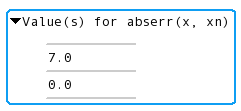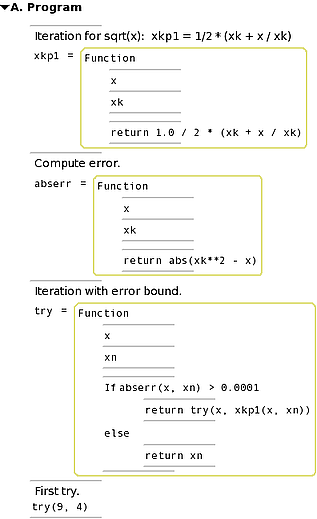Implement a simple iteration to compute sqrt(x), and examine
intermediate results. This example uses no extra code to export
intermediate data for examination; instead, intermediate data is
picked out manually and used in a calculator style.
1 A very simple script
We take the textbook definition 1 of the algorithm for  , write
one function to perform one iteration together with a function to
compute the actual error and a function to repeat the iteration until
the error is small enough.
, write
one function to perform one iteration together with a function to
compute the actual error and a function to repeat the iteration until
the error is small enough.
For a test, we try to find  using 4 as a starting guess.
using 4 as a starting guess.
# Iteration for sqrt(x): xkp1 = 1/2 * (xk + x / xk)
def xkp1(x, xk):
return 1.0 / 2 * (xk + x / xk)
# Compute error.
def abserr(x, xk):
return abs(xk**2 - x)
# Iteration with error bound.
def try(x, xn):
if abserr(x, xn) > 0.0001:
return try(x, xkp1(x, xn))
else:
return xn
# First try.
try(9, 4)
Pasting this results in
We run this to get the (value, timestamp) pair
(3.0, 54)
2 Accumulated values
The result seems promising, but we want to see how fast the iteration
converged. The term abserr(x, xn) is a natural source of this
information, so use insert values as … :
to get a list of computed values:

It looks like 4 is a poor starting value, resulting in single-step convergence. We should try a different starting point; paste and append another test
try(9, 8)and run the program again (L3 only runs the new code) to get
(3.0000153600393218, 264)or similar.
To only display values produced from try(9, 8), select
both abserr(x, xn) and try(9, 8) and use insert values… to get
3 The real error
The values abs(xk**2 - x) are only used to test for some kind
of convergence; we really want to see the sequence of values of xn.
Use the same selection approach to get them:
In plain text form,
8 4.5 3.25 3.00961538462 3.00001536004
Of more interest is the error  and its square. We can use
the last computed value as the "true" value of
and its square. We can use
the last computed value as the "true" value of  , and form the
difference in a convenient spot in the same script.
, and form the
difference in a convenient spot in the same script.
To get extra values to work with, we decrease the error bound to
0.000 001 and re-run the script. As usual, L3 only computes the new
value2.
The last of those values is 3.00000000004; inserting the expression
abs(xn - 3.00000000004)in the script, re-running it, and inserting the list of these gives the following: -----------
Footnotes:
1 This algorithm is chosen to illustrate data selection in L3 only;
for a proper implementation of sqrt(), see
e.g. http://www.netlib.org/fdlibm/e_sqrt.c
2 The first retrieved values are
Showing only data created through: try(9, 8) clone id, clone timestamp, value -------------------------------------------- 32864, 91, 8 32931, 136, 4.5 32998, 181, 3.25 33065, 226, 3.00961538462 33132, 271, 3.00001536004and after replacing the error bound and re-running, the new values retrieved are
32864, 91, 8 32931, 136, 4.5 32998, 181, 3.25 33065, 226, 3.00961538462 33132, 271, 3.00001536004 33292, 349, 3.00000000004so we can see that the originals are used unchanged.




